DAM Trends Report Series
The 2026 DAM Trends Report
Welcome to the 5th annual DAM Trends Report!
This year’s report is based on survey responses from a diverse group of organizations actively using Digital Asset Management systems to power their brand, content, and creative operations.
Respondents represent a wide range of industries, with the highest participation from nonprofit, higher education, healthcare, manufacturing, and technology sectors; industries where large content volumes, distributed teams, and brand governance needs are most pronounced. Most organizations surveyed operate at scale: nearly 60% have over 1,000 employees, and many manage global or multi-regional operations.
Our respondents also span multiple functional disciplines, including marketing, creative, IT, and brand management, with roles ranging from digital asset managers and creative directors to marketing managers and VPs, highlighting DAM’s cross-organizational impact from strategic brand direction to day-to-day content execution.
Across all segments though, one theme is clear: DAM is critical infrastructure for content orchestration. It is a central platform enabling brand consistency, operational efficiency, and scalable collaboration in environments where content complexity continues to grow.
The 2026 DAM Trends Report showcases how teams are using digital asset management software today, and the emerging capabilities they expect to rely on next.
Trend 1
DAM at the Core of the Brand Ecosystem
Digital Asset Management (DAM) platforms now sit at the center of the brand ecosystem. They ensure that every campaign, channel, and partner touchpoint is powered by accurate, consistent, and accessible brand assets. With a digital asset management solution, organizations can unify their creative, marketing, and compliance workflows; unlocking efficiencies that directly impact brand performance.
The Evolution of Brand Management and Ecosystems

As brand ecosystems evolve through 2026, digital asset management software is transforming from a repository into the intelligence layer of brand management. It now connects creative automation, AI-driven metadata, and trust frameworks such as Content Credentials (C2PA) to ensure every brand interaction is authentic, compliant, and on-brand.
Amid tightening budgets (Gartner reports that marketing budget averages just 7.7% of revenue), organizations are consolidating tech stacks and leaning on DAM to deliver measurable ROI in efficiency, governance, and creative velocity.
How does DAM impact brand consistency?
A DAM ensures every team and partner works with the right logos, templates, and approved creativity; eliminating off-brand executions. In fact, 77% of survey respondents reported improved brand consistency since adopting DAM.
A business with consistent branding tends to experience up to 20% greater overall growth and 33% higher revenue compared to one that struggles with off-brand content.
The Brand Consistency Report, Marq
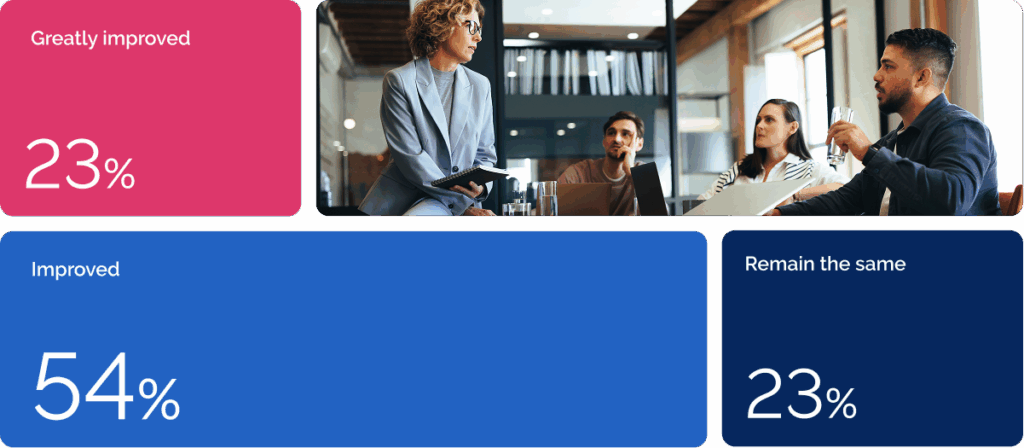
The next generation of brand management relies on AI-powered consistency; automatically tagging and surfacing the right creative for every region, audience, and platform. As teams adopt global brand hubs and templating tools, DAM systems like MediaValet enable ‘governed creativity’ by empowering distributed teams while maintaining control.
When DAM is at the core of the brand ecosystem, in place with the right features and integrated technologies, like a templating solution and a brand hub, brand consistency jumps from 77% to 88% — an increase of 11%.
+11%
DAM can also enable an organization to overcome: cross team collaboration issues, poor brand education, brand governance mistakes, and finding assets.

How does DAM save time on branding initiatives?
By eliminating redundant searches and versioning issues, DAM saves significant time on brand-related tasks. On average, teams report saving 11 hours each week; time that can be reinvested into creative work, campaign strategy, and innovation.
The outcome? With DAM alone, 45% of respondents achieve ROI in 6 months, but DAM and templating working together, that increases to 71% of respondents achieve DAM ROI in less than 6 months.
>6mo
71% of respondents achieve DAM ROI in less than 6 months.
AI-powered DAM alone saves a whopping 11 hours a week on branding initiatives. Integrate it with the right brand ecosystem tools like a templating solution, and increase that to as much a 18 hours a week—or half a working week.
18hrs
These time savings mirror a broader industry trend. As AI tools automate metadata creation, asset routing, and version control, there are incredible outcomes: 35% of marketing teams using DAM report a faster time to market, 67% see better brand compliance, and 61% improve partner/distributor enablement.
All this can shift focus shift from managing assets to impacting business outcomes.
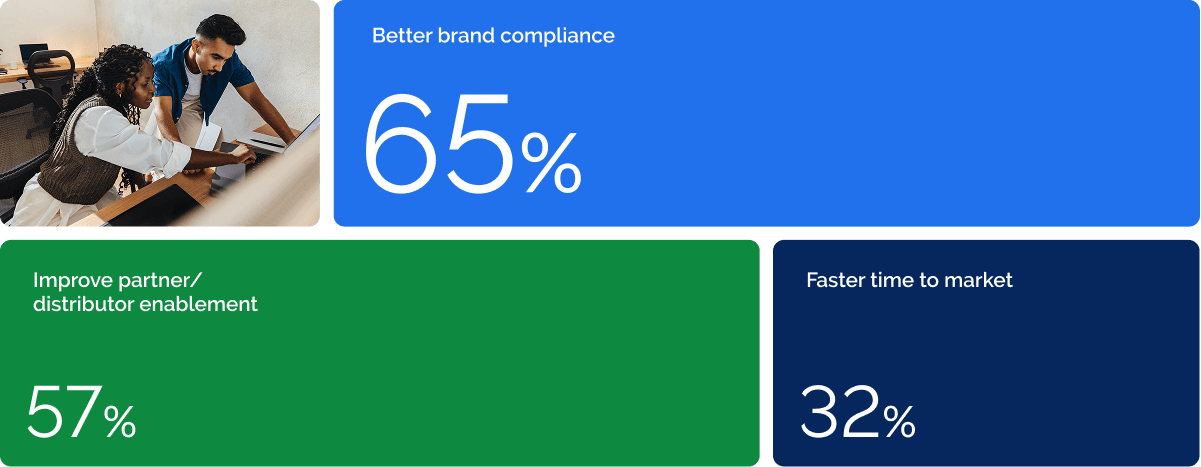
The future of brand management is DAM
Brand management is entering a new era; one defined by authenticity, automation, and measurable impact. By 2026, leading organizations will operate with a governed ‘brand brain’, a digital asset management-centered ecosystem that unites AI, templating, and compliance under one intelligent, secure platform.
Trend 2
DAM at the Core of
Video Asset Managment
DAM has become the backbone of modern video operations.
Based on the recently released Video Asset Management Report, 100% of organizations using DAM for video management are satisfied with their tool vs. just 66% of cloud storage or project management tool users.
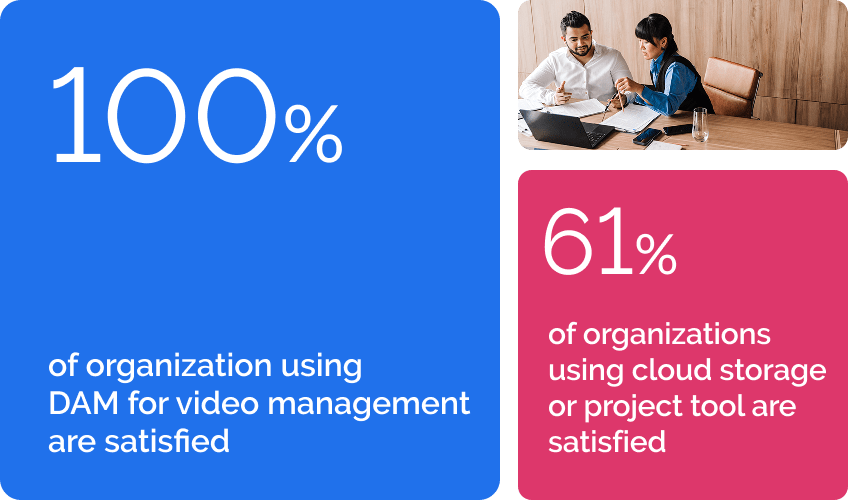
As video volume, formats, and distribution channels expand, organizations require a single system to control, activate, and maximize their most dynamic content. DAM centralizes video workflows, streamlines collaboration, and ensures that every team can access, edit, and share approved footage with speed and confidence.
As video ecosystems mature, DAM is shifting from a storage system to an intelligent command center for audio-visual content. With AI-driven metadata, compliance automation, and direct-to-channel publishing, organizations are now treating video as a core business asset; not just a creative output. The result is faster delivery, measurable ROI, and new opportunities for repurposing and reuse at scale.
Amid rising production costs and shrinking timelines, DAM gives teams the power to accelerate video creation and eliminate the manual tasks that slow them down.
Video is the new core asset
Video has become one of the most valuable digital assets organizations manage. Based on survey data, 83% of respondents reported managing video in their DAM, highlighting video’s expanding role across brand, education, and internal communication.
Last year, only 68% of organizations reported their DAM as their video storage system, but that number has grown to 83% of organizations in 2026 — a 15% increase in just 1 year.
83%
Which assets do you store in your asset management solution?
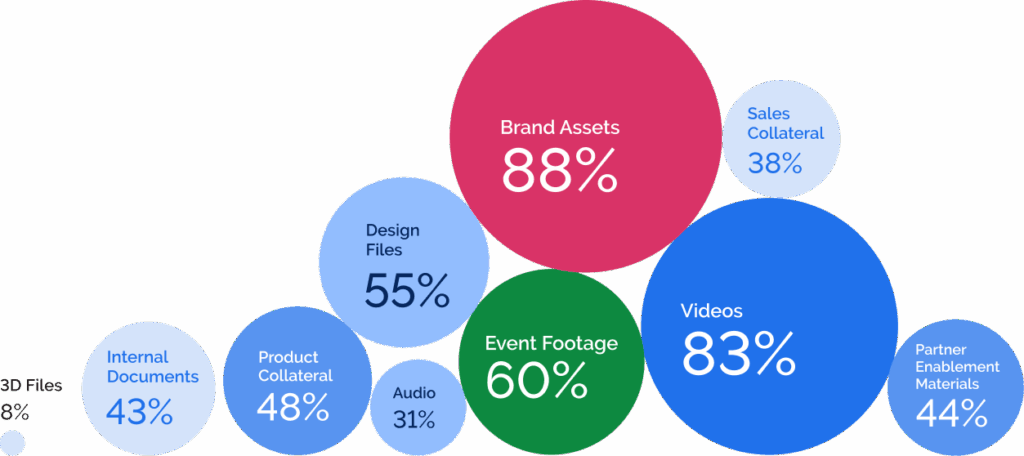
And it’s pretty clear why: video management is no longer just about storage, it’s about speed and accessibility.
71% of teams distribute video directly through social or web channels from their DAM, and 73% report time savings from AI-powered workflows that support transcription, translation, and clip search.
AI and the audio-visual revolution
AI is redefining how organizations manage and extract value from video. More than half (53%) of respondents use Audio Visual Intelligence (AVI) for search, transcription, and translation, signalling that video AI has entered the mainstream.
AVI turns hours of footage into searchable, reusable, and shareable clips. Among survey respondents, 77% reported that AVI capabilities are unlocking up to $1,000 in monthly savings (with a smaller, but meaningful group of about 23% seeing $1,000–$5,000 in monthly savings), driven by reduced duplication, faster localization, automated tagging, and streamlined approvals.
And the savings go beyond financial; those using DAM for video workflows are saving about 9 hours per week on video-related tasks.
The result? An average of 9 hours saved on video workflows per week.
9hrs
What is the impact of digital asset management for video management?
Organizations are already seeing meaningful returns from managing video in their DAM:

With centralized storage, AI-powered metadata, and automated distribution, digital asset management platforms transform video from a static archive into an engine of creative productivity and cross-department collaboration.
The future of video management is DAM
Video management is entering a new era; one defined by intelligence, automation, and continuous activation. In 2026, leading organizations will rely on DAM to detect copyright generate multilingual captions, surface reuse opportunities, and provide real-time distribution insights.
DAM is no longer a tool for video storage—it’s the operational foundation that powers every stage of the video lifecycle, from capture to creation to global delivery.
Trend 3
DAM at the Core of Effective Project Managment
Project management platforms like Wrike, Asana, and Monday.com have long orchestrated team workflows, but without DAM, they’ve lacked the creative backbone needed to manage visual assets effectively. Now, integration between DAM and project management (PM) systems is transforming how creative operations function.
The rise of the connected workspace
In the 2026 survey, 84% of respondents use a project management tool alongside DAM, with Monday.com (18%), Jira (13%), and Asana (26%) leading the pack.
However, only 21% of DAM users report full integration with a PM platform signalling a significant opportunity for growth if your organization is one of the 79% not fully integrated yet.
When truly connected, DAM and PM create a closed feedback loop:
How do DAM and PM affect workflow efficiency and time savings?

Among integrated users, teams reported:
How does DAM strengthen governance in project management systems?
DAM adds the governance layer that Project Management tools lack alone; version tracking, rights management, and approval history transforming project management from coordination to controlled execution.
According to survey data shows 71% of respondents rely on DAM for streamlined approvals, while 65% cite centralized version control as their most valued collaboration feature.
Which governance features matter most in project management workflows?

This governance layer is what ensures brand integrity and compliance even as workloads scale. It eliminates redundant reviews, reduces content risk, and creates an unbroken record of asset changes. As a result, creative teams move faster and with more confidence, knowing that every asset version, approval, and usage right is traceable.
The future of project-led DAM
As generative AI becomes embedded in project management ecosystems, expect DAM to provide the intelligent asset foundation; automatically linking metadata, recommending assets for upcoming campaigns, and routing approvals in real-time. In 2026, DAM-integrated project management will evolve into orchestrated creative operations, powered by predictive asset insights.
Already, 70% of teams report cross-functional collaboration gains tied to DAM-PM integrations, while 76% highlight improved asset accessibility and approval visibility as the biggest benefits of connecting the two systems.
In the coming years, digital asset management software will evolve to not only store and track assets but intelligently predict what’s needed next.
Trend 4
DAM at the Core of the Future of Work
The workplace has evolved beyond location, and DAM is evolving with it. As remote and hybrid work models become standard, teams are no longer defined by geography. They are defined by shared access to information, alignment on brand, and the ability to collaborate without friction.
As remote and hybrid teams become the norm, access, compliance, automation, and collaboration have become the new success metrics for creative productivity. Digital asset management is no longer a storage solution; it’s the operating layer that holds distributed organizations together.
The future of work is a distributed reality
According to the 2026 DAM Trends survey, 91% of respondents say remote and hybrid access to DAM is important. And, while 100% of respondents access DAM via desktop, nearly 45% also use mobile to access the DAM, showing a clear shift toward flexible, device-agnostic workflows.
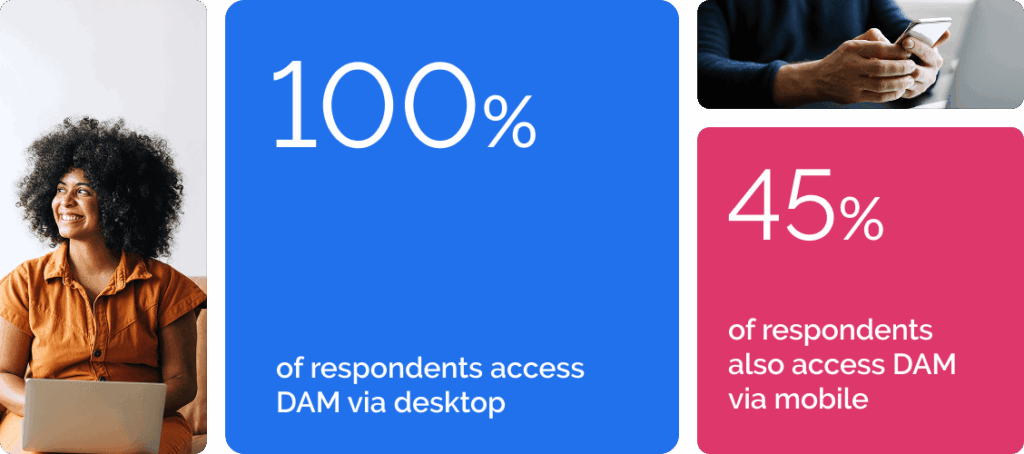
Mobile access isn’t just a convenient feature, it’s a measurable adoption driver.
43% of respondents reported increased platform adoption after introducing mobile access to their DAM.
43%
This matters because adoption is the single strongest predictor of DAM ROI. If users don’t use the system, brand governance breaks, duplication resurfaces, and asset chaos returns. Mobile access lowers the entry barrier: stakeholders can find, approve, or share content in the moment they need it, not hours later when they’re back at their desk.
How is DAM enabling global collaboration?
Hybrid and global teams aren’t just sharing files; remote teams are using DAM to coordinate creative, marketing, campaign execution, and brand governance across regions, time zones, and partner networks.
Survey respondents confirm this shift:
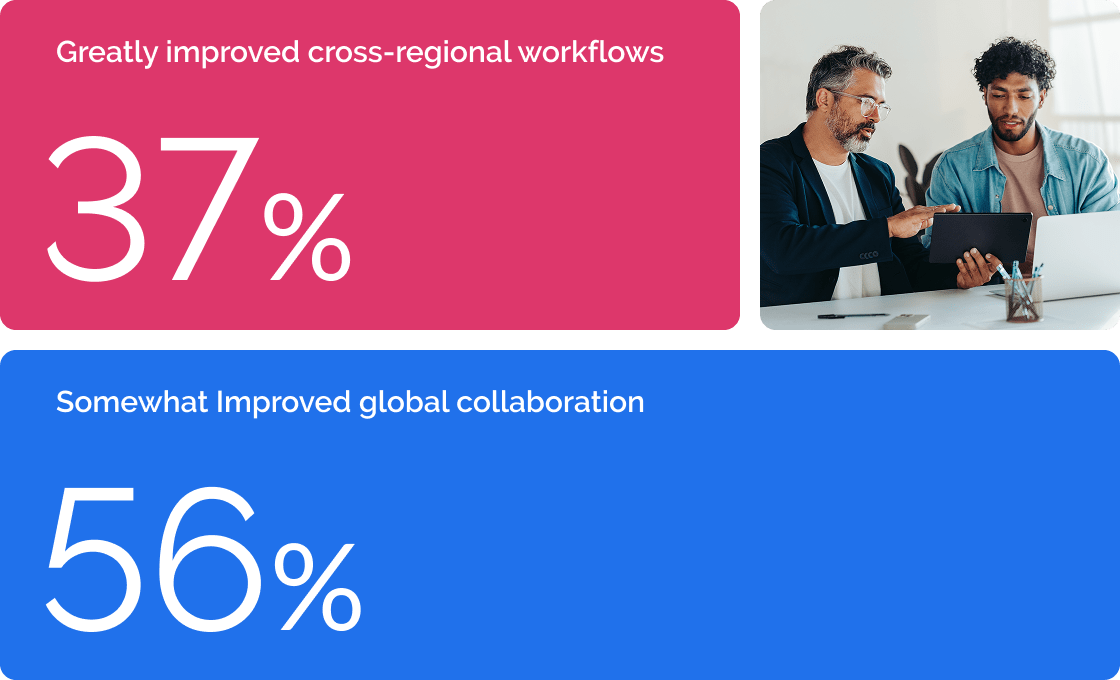
93% of survey respondents see DAM as a core element of improved global collaboration.
93%
What’s powering the global collaboration improvement?
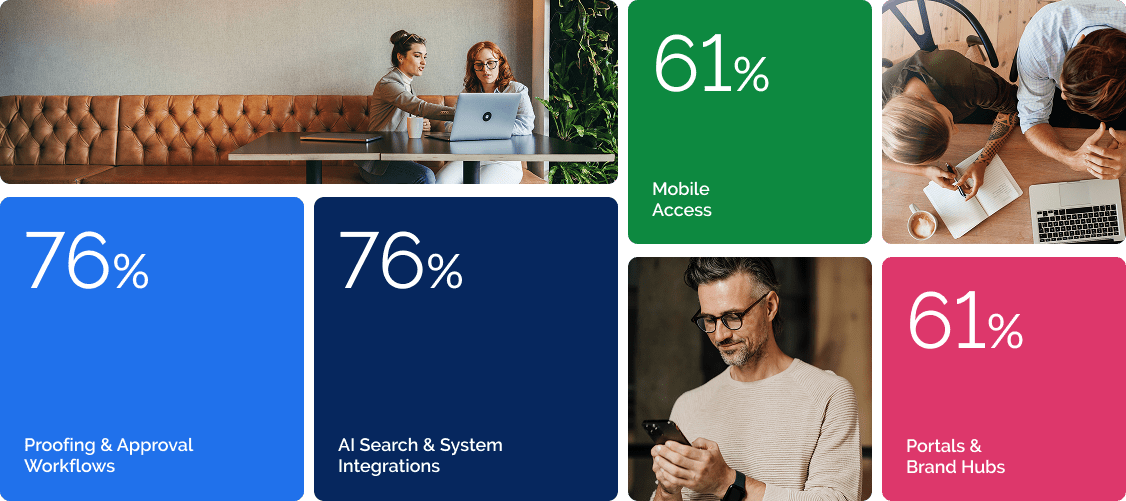
While teams have adopted DAM for storage, they’re relying on DAM for better coordination. The future of work depends on seamless access, governed creativity, and real-time collaboration — all powered by DAM.
How is digital asset management enabling global compliance?
In the distributed workplace, compliance is no longer confined to a single region or department, it’s a shared responsibility spanning global teams, partners, and creative ecosystems. Digital Asset Management now plays a central role in ensuring that governance scales alongside creativity.
According to the 2026 survey, 65% of respondents are satisfied with their DAM’s ability to meet compliance requirements such as GDPR and HIPAA. This confidence is rooted in DAM’s structured approach to access control, audit trails, expiry management, and encryption; features that make compliance part of the workflow rather than an afterthought.
49% of respondents are satisfied and another 16% highly satisfied with their digital asset management system’s ability to meet compliance requirements.
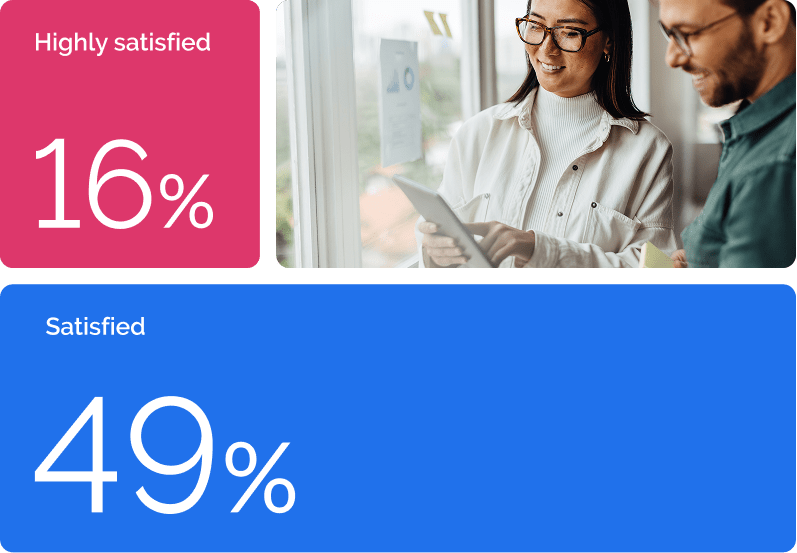
Why is compliance important?
41% of businesses without continuous compliance report slowdowns on the sales cycle as a result (Drata).
When teams operate across borders, that foundation becomes mission-critical. 60% of organizations report using DAM to collaborate safely across multiple regions without compliance risks, and nearly 70% say digital asset management systems have directly improved compliance in their organization.
AI-powered DAM is now amplifying these safeguards. Respondents ranked automated tagging of sensitive data (41%), Face Recognition (59%), AI-driven access permissions (18%), and real-time compliance alerts (26%) as the most valuable features enabling compliance. Together, these tools turn governance into an intelligent, proactive layer — one that detects risks, enforces regional regulations, and maintains trust across every market.
The next frontier however is predictive collaboration. Our respondents called out the most important features they’re on the look out for; where DAM recognizes user behavior patterns to surface relevant content, alert users to outdated materials, and suggest workflow improvements.
Respondents cited their top desired features for the next 2–3 years as:
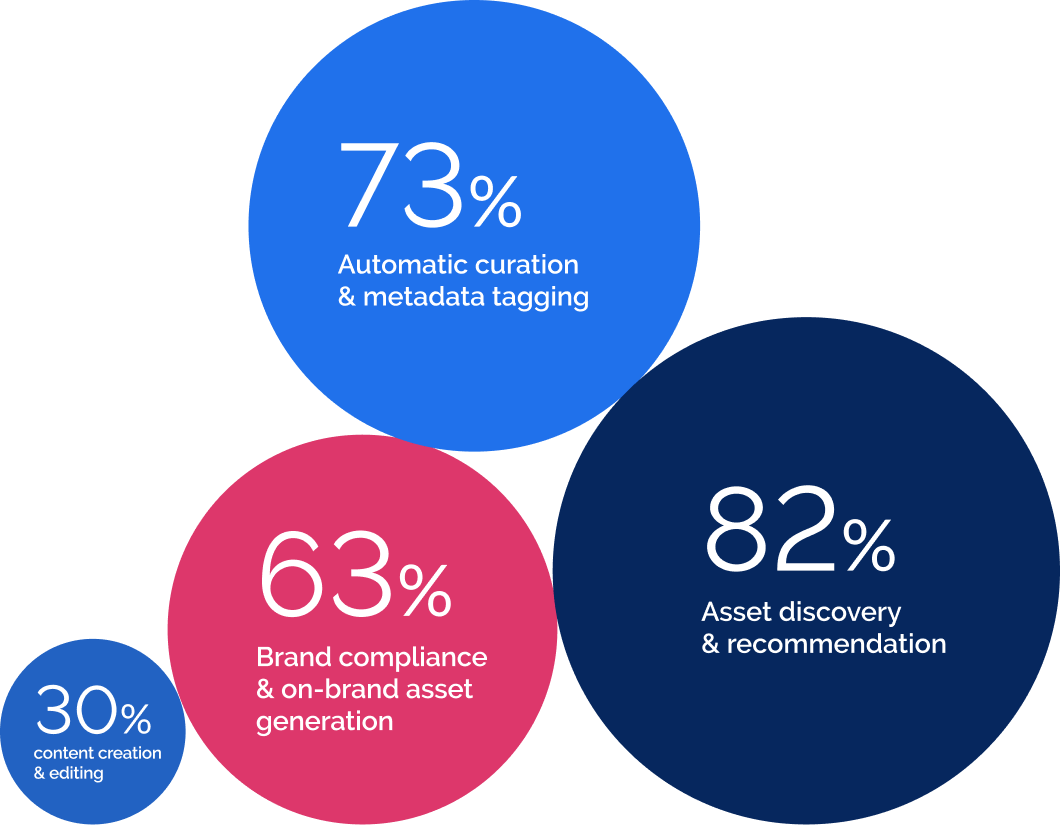
The future of work is DAM-powered
As organizations balance flexibility with control, DAM provides the single source of truth that keeps distributed teams aligned and efficient. And as content becomes more global and regulations more granular, AI-powered digital asset management ensures that creative freedom and regulatory rigor can coexist.
In 2026, the workplace will no longer revolve around shared drives or scattered approvals; it will revolve around a DAM that knows what each user needs, when they need it, and how to keep every brand expression consistent.
The 2026 DAM Trends Report reflects a shared reality: content, teams, and brand expectations are only getting more complex, and a digital asset management platform is now essential for keeping work connected, consistent, and scalable.
If you’re exploring what comes next for your organization, take the DAM Needs Assessment, a quick guided exercise to clarify your priorities and maturity stage.
If you’re ready to see how a leading digital asset management vendor like MediaValet can centralize your content infrastructure and transform the way your teams collaborate and create, book a demo with our team.
Frequently Asked Questions about Digital Asset Management
The DAM Trends Report is an annual, data-driven analysis of how organizations are using Digital Asset Management software to improve brand consistency, accelerate content operations, strengthen compliance, and unlock new value from AI.
The 2026 edition includes insights from organizations across industries, including nonprofit, higher education, healthcare, manufacturing, government, and technology and reflects teams of all sizes, from mid-market to global enterprise.
The report examines:
– Time savings across brand, content, and video workflows
– How DAM integrates with project management systems
– The rise of AI-powered metadata, compliance, and automation
– The evolving needs of distributed and remote teams
– The shift toward DAM as the core of the content ecosystem
The DAM Trends Report serves as a benchmarking resource for marketing, creative, operations, and digital leaders assessing their current workflows and planning future content infrastructure.
A Digital Asset Management (DAM) system centralizes all digital files: images, videos, documents, templates, and makes them easily searchable, governed, and shareable across teams.
Brand Asset Management (BAM) tools, on the other hand, focus primarily on brand consistency and providing access to approved brand assets.
Think of BAM as a subset of what DAM does. DAM improves the entire content lifecycle, while BAM focuses on the brand layer.
DAM connects directly with PM platforms like Wrike, Asana, and Monday.com to bring version control, approval workflows, governance, and asset visibility into project tasks.
A DAM and PMS integration eliminates duplicate work, ensures teams always use the correct assets, and reduces approval timelines.
That’s why 71% of 2026 DAM Trends survey respondents say DAM streamlines collaboration in PM systems.
While VAM platforms specialize in handling video-specific workflows like editing, transcribing, clipping, and distribution; DAM offers a broader, multi-format approach.
A modern DAM includes powerful video capabilities (AI tagging, transcription, versioning, and secure delivery) while also supporting images, documents, templates, and more.
For most organizations, a DAM replaces the need for a separate VAM entirely.
Read the Video Asset Management Report to find more detailed information on DAM vs VAM.
Enterprise DAM platforms like MediaValet use role-based access control, SSO, audit trails, encryption, redundant storage, multi-region hosting, and detailed permissions to ensure that teams across global markets work securely.
According to the 2026 DAM Trends Report, 69% of teams cite governance and access controls as critical compliance enablers, especially for organizations navigating GDPR, HIPAA, and region-specific content regulations.
You can learn more about DAM security measures here.
Organizations typically outgrow their existing content systems long before they realize it. The signs are clear: slow or inconsistent search results, frequent asset duplication, version-control issues, scattered approvals, and rising off-system storage (Google Drive, SharePoint, desktops).
You may also be ready to migrate to a new DAM if:
– Adoption is low and users avoid the platform
– Integrations or metadata structures no longer meet your needs
– Your DAM can’t support video workflows, templating, AI, or compliance requirements
– Your vendor charges per-user fees that restrict scaling
– You’re stuck in a long-term contract that limits innovation
If your current DAM is limiting your growth, migration is often the most cost-effective path forward.
You can learn more about migrating DAM system in this webinar.
DAM pricing typically depends on your storage needs, feature requirements (AI, templating, portals, video tools), and support level. But not all pricing models are created equal.
MediaValet offers unlimited admin and end users, allowing teams to grow, collaborate, and adopt the DAM freely, without hidden seat fees or budgeting constraints. This means:
– No penalties for scaling
– No surprise fees as your team expands
– Predictable pricing that supports long-term growth
Platforms like Bynder use tiered pricing models that require teams to confirm user numbers in advance.
Frontify charges by Monthly Active Users (MAU) so every unique login in a month adds to your bill. This discourages occasional or external users. Growth is possible, but it requires ongoing budgeting, forecasting, and costs every time new team members join.
MediaValet, on the other hand, includes unlimited users at no extra cost, ensuring adoption across your entire organization without surprise charges. Learn more about MediaValet’s Digital Asset Management Pricing here.
Ready to explore a better DAM?
Choosing MediaValet is about more than storage; it’s about empowering your teams to work smarter, scale faster, and eliminate the friction that holds creativity back. If other DAM’s seat-based pricing, limited AI tools, or slower time-to-value are getting in your way, MediaValet is ready to help.
Book a demo today and see how we can help you: